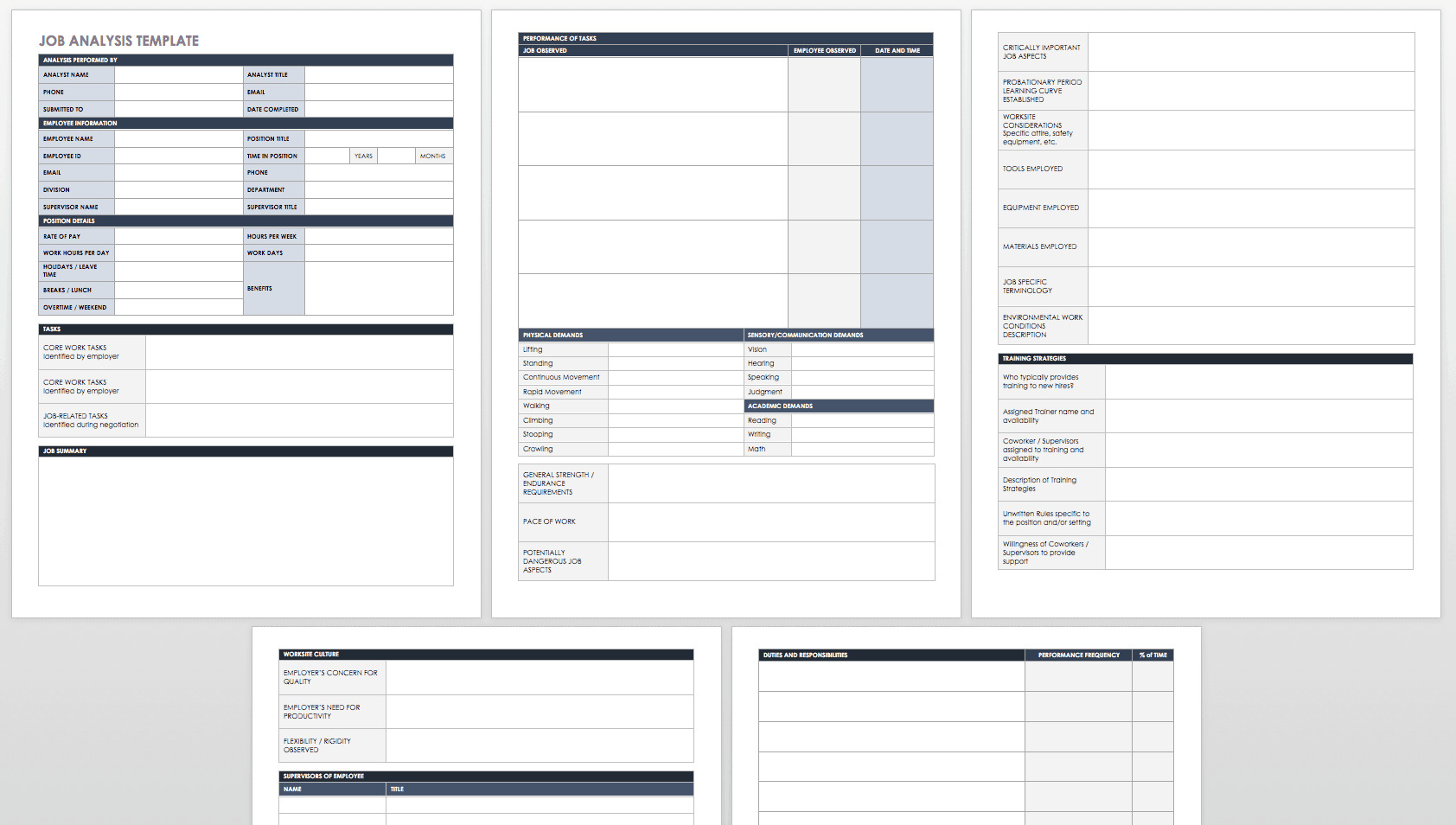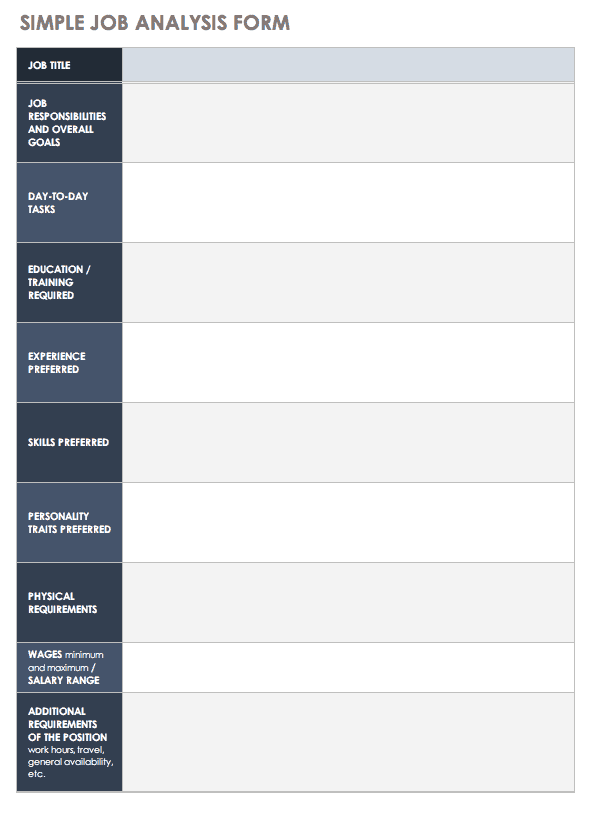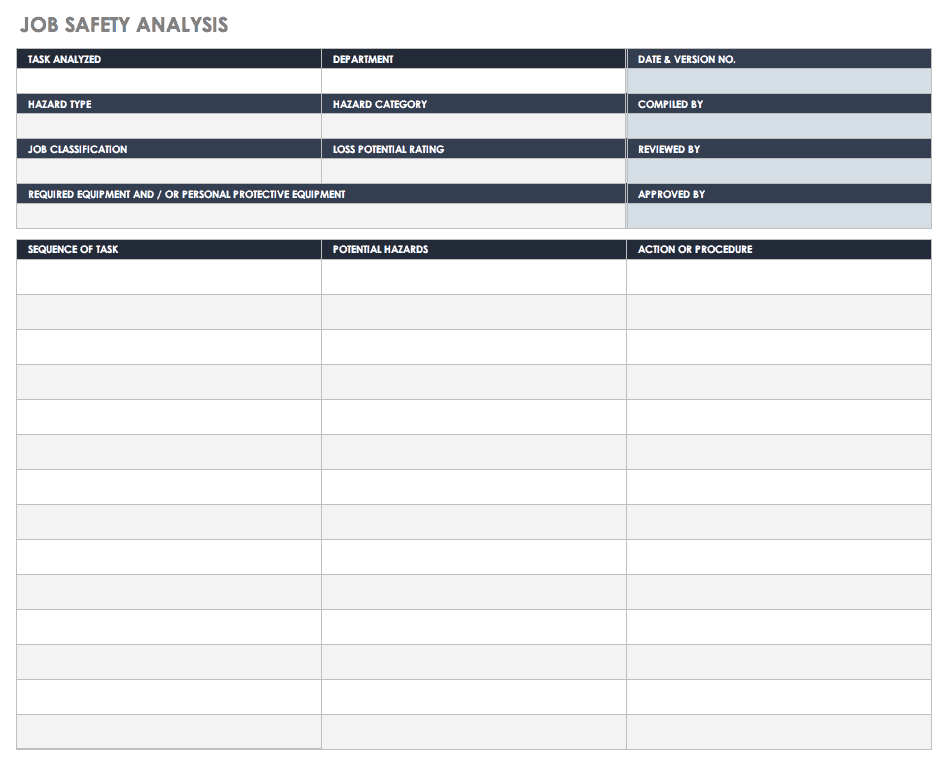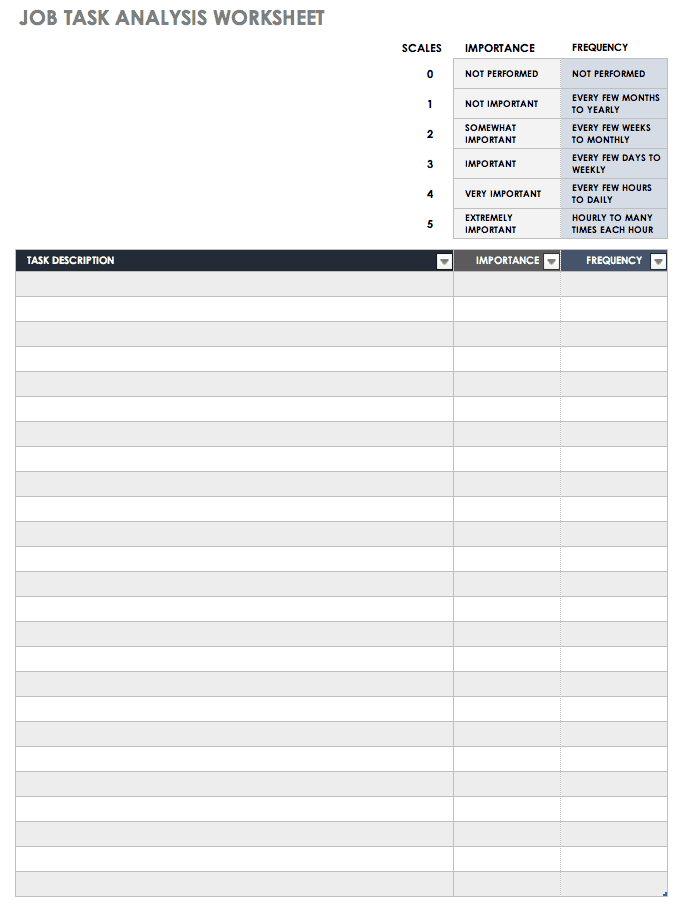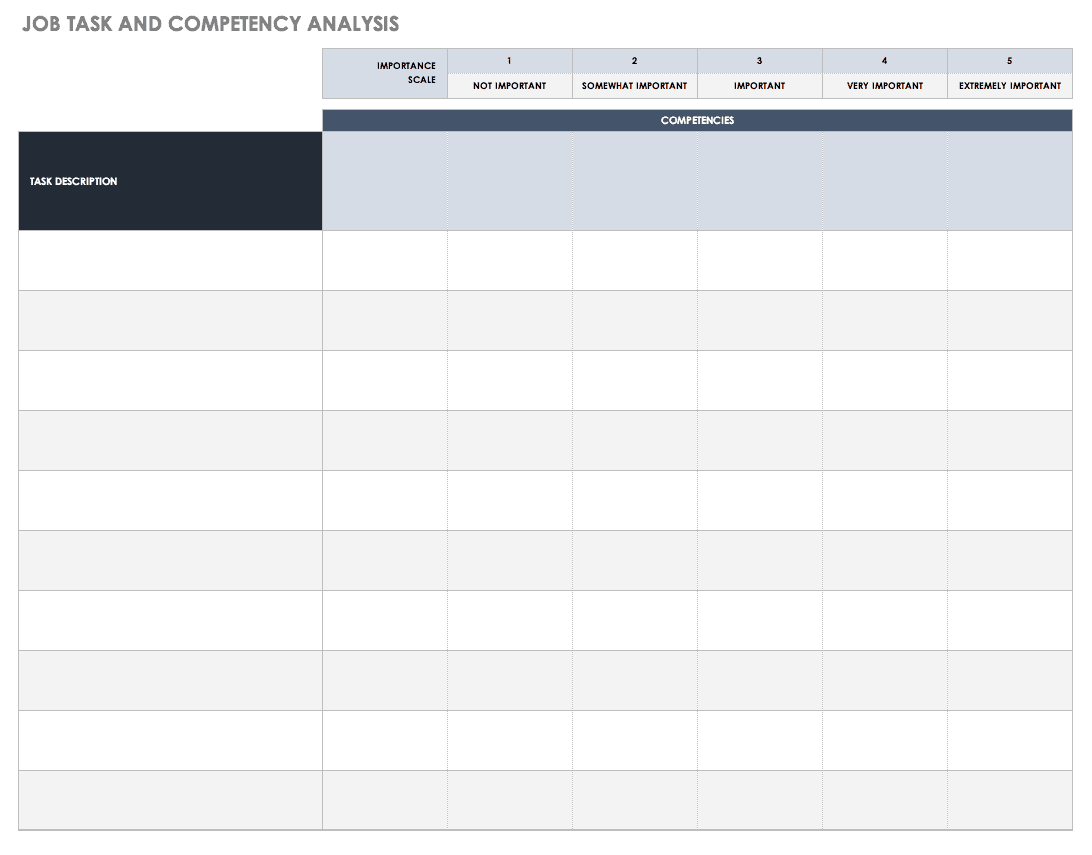Job Analysis Template
Use this template to create a comprehensive job analysis report that covers the core tasks and competencies, physical demands, necessary education, and other requirements. The template can serve as a starting point for creating your own customized form. Include signature lines at the bottom of the template if you want to document approval or completion dates.
Download Job Analysis Template
Word | PDF | Smartsheet
Simple Job Analysis Template
If you need to complete a basic job analysis with less detail than the templates offered above, this form provides a simple outline to follow. It may be useful for analyzing jobs that are less complex, creating simple job descriptions, or abridging information from a more thorough analysis in a brief summary report. Edit the form to include whatever information is relevant for the job you are analyzing and the purpose of the analysis.
Download Simple Job Analysis Template
Excel | Word | PDF | Smartsheet
Employee Job Analysis Template
This job analysis is designed to allow an employee to answer questions about their job, such as duties and responsibilities, the amount of time spent on various tasks, the experience needed, and the people who they communicate with (either internally or externally). Other questions may relate to skills, knowledge, and certifications required for the job. The template can also be used for an interview format in which the interviewer asks employees questions, discusses the answers, and then records those answers.
Download Employee Job Analysis Template
Job Safety Analysis Template
A job safety analysis (JSA) helps identify and address potential hazards that might result from various job tasks. On this template, record the tasks or sequence of steps involved in a job, the potential dangers, and the actions that can be taken to control or remove the safety issues. This hazard analysis template also includes space for listing personal protective equipment needed for the job and details, such as the job location, the date of the analysis, and the name of the person who completed it.
Download Job Safety Analysis Template
Job Task Analysis Worksheet
This job task analysis template includes rating scales for evaluating the importance and frequency of various duties. The importance scale ranges from “not important” to “extremely important,” and the frequency scale ranges from “every few months” to “many times per hour.” Both factors can also be marked as “not performed,” and you can modify the scale to suit a particular job. Organize and analyze tasks for any job using this simple template.
Download Job Task Analysis Worksheet
Job Task and Competency Analysis
Analyze tasks and competencies to better understand the relationship between the two. List the job tasks on the left side of the template, add competencies to the top portion of the template, and then use the rating scale to evaluate the importance of each competency for a given task. This process can help illuminate how core tasks and competencies are linked.
Download Job Task and Competency Analysis
Benefits of a Job Analysis
Any type of analysis involves breaking down a whole into parts in order to understand the relationships among the different parts. An important part of human resource management, a job analysis can help a company thoroughly understand the responsibilities involved in different roles, allowing for more accurate job descriptions, effective training materials, clear expectations for employees, and informed hiring decisions.
A job analysis can also help ensure that a new candidate for a position has the essential qualities and experience required and that the pay grade for a job is appropriate. A job analysis can also be used to examine how a job could be improved by adjusting a process or work environment or delegating responsibilities.
Understanding the Job Analysis Process
There are a few methods for carrying out the job analysis process. In some cases, an analyst may observe a job being performed and record those observations. Other options include interviewing individual employees or groups about the jobs they perform, having employees fill out a job questionnaire, or asking employees to keep a daily record of tasks performed. Technical experts or written materials related to industry or performance standards may also be consulted in order to collect information about the characteristics and requirements of a job.
The basic job analysis process involves gathering information about a job, including a detailed list of tasks and related competencies, and then using a rating scale to determine the frequency and importance of those required tasks. A task analysis is one component of a job analysis, but it may also be conducted separately in order to evaluate a work process or get a better understanding of certain tasks. Here is an example of a job analysis that shows tasks and related competencies for the purpose of identifying what requirements a new employee would need to meet:
Employees do all kinds of activities throughout a day, and some tasks are obviously more important than others for successful job performance. If you are conducting a job analysis to determine which tasks are critical to a job, here is an outline of the steps you can take:
- List the required tasks for a job.
- Rate each task based on how important the task is and how frequently it is performed.
- Calculate the average rating for each task, excluding any that were rated as “not performed.”
- Determine which tasks are critical to the job by including only those that meet a minimum average score. (Determine that threshold based on the type of rating scale used in the analysis.)
- Use the same process to identify and rate competencies in order to determine which ones are critical to the job.
- Connect the critical tasks with the critical competencies based on what competencies are required to complete each task.
- Eliminate any tasks and competencies that are not linked.
You can use this kind of detailed task analysis to streamline work processes and increase efficiency. It can also reveal which activities and competencies need further assessment beyond using a basic rating scale. The main purpose of a job analysis — whether your intention is to hire a new employee, enforce safety standards, or evaluate a pay scale — is to collect job information that can be analyzed effectively in order to meet your objective.
Creating a Job Analysis Template
Since both the type of job and purpose of an analysis will vary, there is not a one-size-fits-all template solution. But, there are similar elements typically included in a job analysis. Here is a list of items that you may want to include depending on the job and your reason for conducting an analysis:
- The Basics: Information like the job title, associated department, name of supervisor, and names of employees interviewed or observed may all be included as identifying information. You may also want to include the salary range for the position.
- Summary of Job Scope: A brief summary of the job’s purpose and responsibilities provides an overview and context for the analysis.
- List of Tasks: You may provide a short description of each task, in addition to the frequency of job duties performed.
- Work Contacts: This may include people who are contacted by the person performing the job, along with the reason for and frequency of contact to determine the importance of the communication and the skills required.
- Decision-Making Authority: You may include information on the reporting structure for the job, supervision received, employee’s latitude for making important decisions, and other factors.
- Supervisory Responsibility: If the job involves supervising others, you may list the names of those employees. This is also an opportunity to examine the level of supervision and the type of work direction being offered.
- Physical Effort: Whether the job entails sitting for long periods in front of a computer or doing manual labor, this section can outline the physical demands involved, including detailed information on bodily positions required, such as bending, lifting, or working in cramped spaces.
- Tools Used: This may relate to physical effort as well as skill, outlining the tools and equipment used on the job.
- Work Conditions: This applies to the work environment, including safety considerations and the amount and quantity of exposure to noise, vibration, dust, or fumes.
- Education and Experience: This includes specific education or training requirements to perform the job as well as the number of years or type of experience needed.
- Skills: Knowledge, skills, and abilities (KSAs) are often grouped together, along with the competencies required to complete tasks. Skills can include the use of specific software or the ability to type, speak a certain language, or communicate effectively over the phone.
- Other Requirements: An additional section may be needed for requirements that don’t fit neatly into one of the above categories, such as frequent travel.
- Rating Scale: A rating scale is typically used throughout an analysis form to determine the frequency and importance of tasks performed, skills used, or hazards encountered.
A job analysis that is focused on creating a job description or hiring the right person may also include information on personal qualities that are required or preferred, such as being detail oriented. Creating an organized template can help standardize procedures, making it easier to implement and repeat the job analysis process.
Improve Job Analysis with Smartsheet for Human Resources
Empower your people to go above and beyond with a flexible platform designed to match the needs of your team — and adapt as those needs change.
The Smartsheet platform makes it easy to plan, capture, manage, and report on work from anywhere, helping your team be more effective and get more done. Report on key metrics and get real-time visibility into work as it happens with roll-up reports, dashboards, and automated workflows built to keep your team connected and informed.
When teams have clarity into the work getting done, there’s no telling how much more they can accomplish in the same amount of time. Try Smartsheet for free, today.
